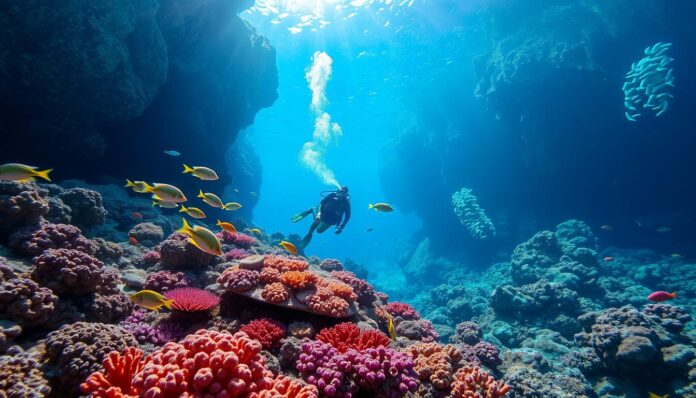Are you ready to unlock the most breathtaking underwater world imaginable? What if I told you the Caribbean holds secrets that will transform your Scuba Diving in Caribbean experience forever?
The Caribbean Sea is a stunning playground for underwater exploration. It offers divers an unparalleled marine adventure. With crystal-clear waters, vibrant coral reefs, and diverse marine ecosystems, this region promises unforgettable experiences for both novice and experienced divers.
From the legendary shipwrecks of the Bahamas to the spectacular marine biodiversity of Belize, the Caribbean presents a diving destination like no other. Each island offers unique underwater landscapes waiting to be discovered.
Key Takeaways – Scuba Diving in Caribbean
- Caribbean offers world-class diving experiences
- Over 300 dive sites across multiple islands
- Warm water temperatures year-round
- Diverse marine ecosystems to explore
- Opportunities for both beginner and advanced divers
- Rich marine biodiversity and unique underwater landscapes
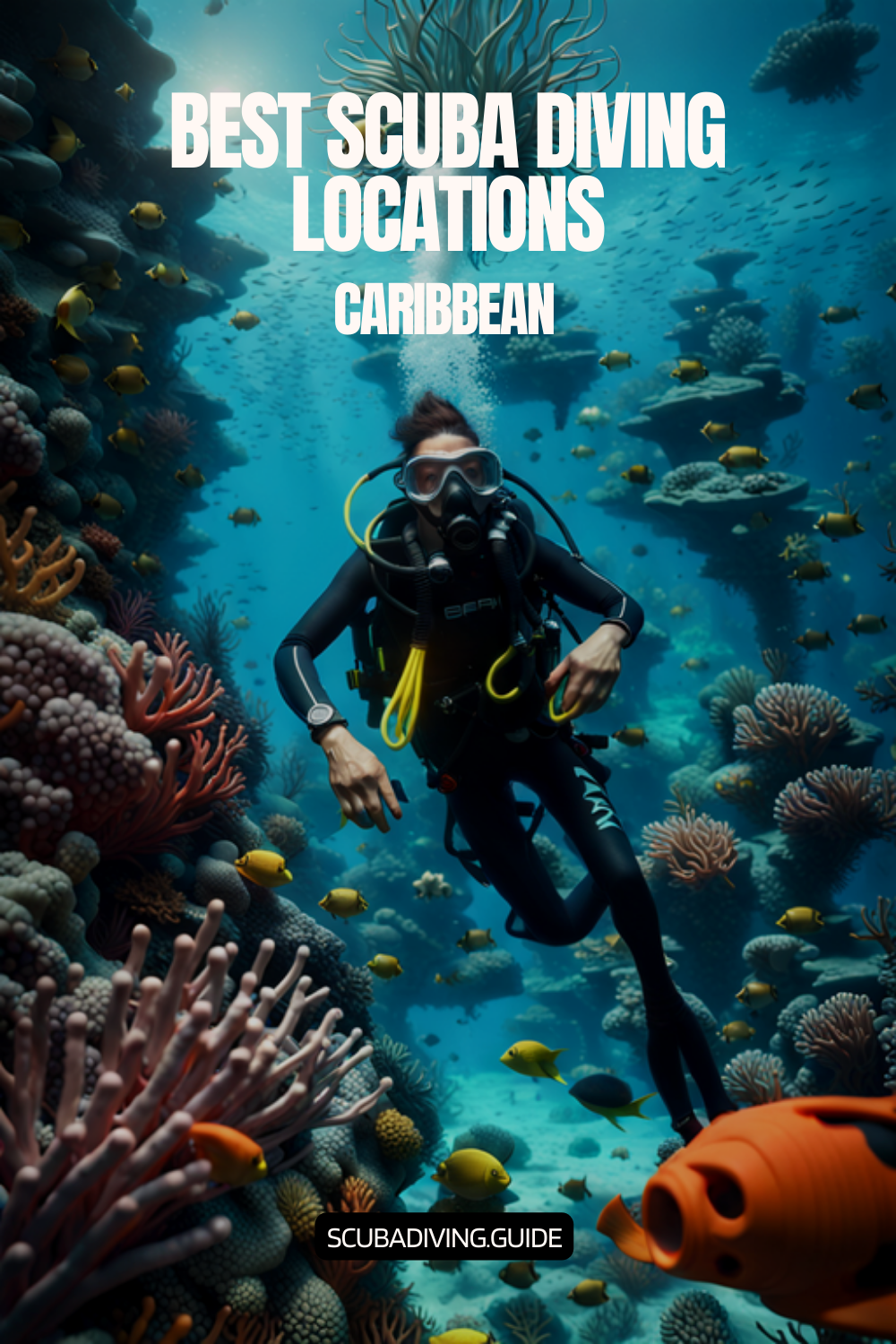
Why Choose the Caribbean for Scuba Diving?
The Caribbean is a top spot for scuba diving, attracting divers from everywhere. It’s an underwater paradise with a unique marine ecosystem. This makes it perfect for exploring and adventure.
There are many reasons why the Caribbean is special for diving. It stands out from other places around the world.
Unique Marine Biodiversity
The Caribbean Sea is full of marine life, with over 12,000 species. Divers can see many different creatures, like:
- Over 1,000 fish species
- Rare marine mammals
- Diverse invertebrates
Stunning Coral Reefs
The Caribbean’s coral reefs are vital for marine life. They make up about 10% of the world’s reefs. The Mesoamerican Barrier Reef is a must-see for its beauty.
| Reef Location | Unique Characteristics |
|---|---|
| Mesoamerican Barrier Reef | Second-largest barrier reef system worldwide |
| Bonaire | Home to 57 coral species and 340 fish species |
| St. Vincent | Rich in smaller marine life diversity |
Warm Water Temperatures
The Caribbean’s warm waters make diving comfortable all year. Temperatures are usually between 77°F and 86°F. This means you don’t need thick wetsuits.
“The Caribbean offers divers an unparalleled underwater world, where marine life and coral reefs create a living, breathing ecosystem.” – Diving Enthuasiast Magazine
The Best Caribbean Dive Destinations
The Caribbean Islands are a paradise for scuba diving. They have diverse marine life, clear waters, and many unique dive sites. These places offer unforgettable experiences for all divers.
Caribbean dive resorts have made these tropical spots top diving spots. Each place has its own underwater world and marine life. This draws divers from all over the world.
Cozumel, Mexico: A Drift Diving Haven
Cozumel is a top diving spot with over 45 dive sites. Its location offers great drift diving. Divers can see colorful coral reefs and enjoy easy underwater currents.
- Over 45 dive sites
- Exceptional drift diving opportunities
- Vibrant marine biodiversity
Bonaire: Shore Diving Capital
Bonaire is known as the shore diving capital of the world. It has over 80 dive sites, all accessible from the shore. Divers can see over 450 fish species and 50 coral types.
| Dive Site Characteristics | Details |
|---|---|
| Total Dive Sites | 80+ sites |
| Fish Species | 450+ species |
| Coral Species | 50+ species |
Grand Cayman: Wall Diving and Marine Life
Grand Cayman is known for its wall diving and marine life. Stingray City lets divers meet gentle stingrays. The USS Kittiwake wreck at 65 feet is another exciting dive.
“Grand Cayman transforms underwater exploration into an extraordinary adventure.” – Diving Expert
These Caribbean Islands are just a few of the amazing dive spots. Each place offers unique marine experiences. They will captivate divers and leave lasting memories.
Types of Scuba Diving Experiences
The Caribbean is a treasure trove for scuba diving. It offers a wide range of underwater adventures. Each dive style lets you see the marine world in a unique way. Whether you’re a beginner or an experienced diver, there’s something for everyone.
Shore Diving: Accessible Underwater Adventures
Shore diving is a great way to start your underwater journey. Places like Bonaire have beaches right next to amazing marine spots. Here, you can:
- Jump into the water right from the beach
- See shallow reefs up close
- Practice diving without carrying much gear
- Go diving whenever you want
Boat Diving: Reaching Remote Marine Ecosystems
Boat diving takes you to deeper, more exciting places. With expert guides, you can explore remote reefs and areas far from shore. Grand Cayman is known for its top-notch boat diving trips.
Night Diving: Discovering Nocturnal Marine Life
Night diving is a magical experience. As night falls, the sea comes alive with creatures that only show themselves in the dark. You’ll see:
- Bioluminescent animals
- Marine animals hunting
- Species you rarely see
- Coral reefs that change color
“Night diving is like entering another world – mysterious, magical, and utterly captivating.” – Caribbean Diving Enthuasiast
With over 500-700 fish species in the Caribbean, every dive is a chance to meet new marine friends.
Essential Gear for Caribbean Diving
Getting ready for a Scuba Diving in Caribbean adventure means picking the right gear. The right equipment makes your underwater photography better and keeps you safe and comfortable. This is key for exploring the vibrant marine life.
Choosing the right gear is important in tropical waters. The Caribbean’s unique sea life needs special equipment. This equipment must protect and perform well.
Wetsuits and Protective Layers
Caribbean waters usually don’t need much thermal protection. Divers can choose from:
- Thin 1-2mm rash guards for warm water
- 3mm wetsuits for cooler areas
- Light materials for sun protection
Tanks and Regulators
Most dive operators give out the basic breathing gear. But, experienced divers might want:
- Personal regulators for comfort
- Backup mouthpieces
- Stuff that works with local dive spots
Dive Computers and Safety Gear
Today, about 80% of divers use dive computers. They help with safety and tracking.
| Essential Electronic Gear | Purpose |
|---|---|
| Dive Computer | Keep track of depth, time, and decompression |
| Underwater Camera | Take photos of the underwater world |
| Personal GPS | Help with navigation and emergency tracking |
“The right gear turns a good dive into an amazing underwater experience.”
For those who love Underwater Photography, think about waterproof camera housings and special lighting. These help capture the Caribbean’s stunning sea life.
Always choose well-kept, quality gear for tropical diving. Good preparation means a safe and unforgettable Scuba Diving in Caribbean trip.
Preparing for Your Diving Adventure
Going on a Caribbean diving adventure needs careful planning and knowledge. The area’s beautiful underwater scenes draw millions of divers each year. Scuba diving adds about $3 billion to the tourism industry. Knowing the basics of your dive trip is key, whether you’re new or experienced.
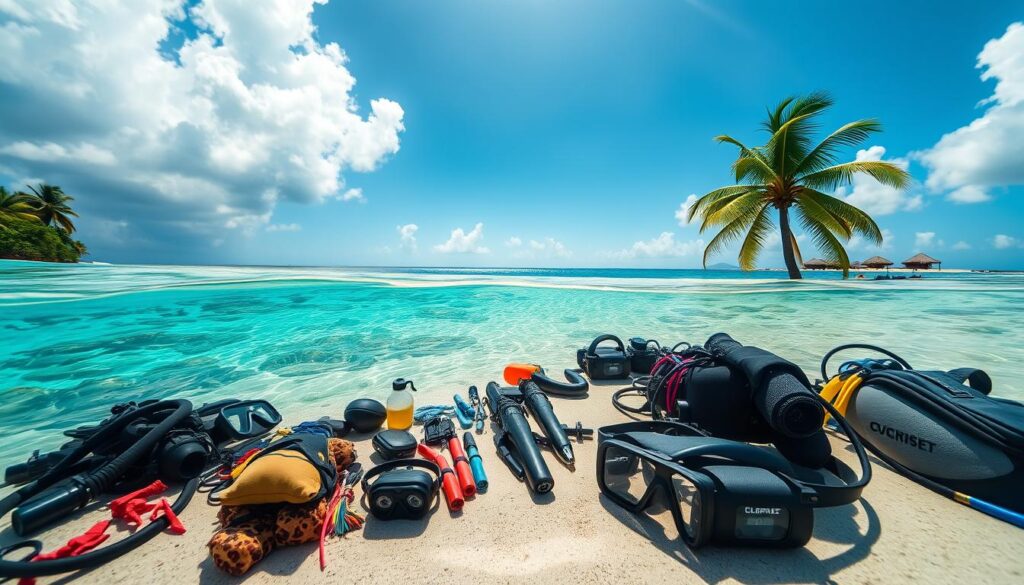
Before diving into the clear Caribbean waters, consider a few important things. They will help make your dive safe and unforgettable.
Getting Certified
Certification Courses are vital for exploring the underwater world. Dive resorts offer training for all skill levels:
- Beginner Open Water Certification
- Advanced Open Water Courses
- Specialty Diving Certifications
Choosing the Right Dive Shop
Picking a good dive shop is key for a great dive. Look at these important factors:
| Criteria | What to Look For |
|---|---|
| Safety Record | Proven track record of safe diving practices |
| Equipment Quality | Well-maintained, modern diving gear |
| Instructor Credentials | Experienced, certified instructors |
| Customer Reviews | Positive feedback from previous divers |
Understanding Dive Conditions
The Caribbean has exceptional diving conditions. Water temperatures are between 78°F and 86°F. Important things to think about include:
- Water visibility (usually 15-30 meters)
- Current strengths
- Seasonal marine life patterns
- Potential environmental hazards
“Preparation is the key to an unforgettable diving experience in the Caribbean.” – Professional Diving Instructor
About 40% of divers need medical clearance. Check with a doctor before your trip. With the right prep, your Caribbean diving adventure will be amazing.
Safety Tips for Scuba Diving
Scuba diving in the Caribbean is an amazing adventure. But, safety always comes first. With the right preparation and awareness, divers can have fun and stay safe.
Safe diving starts with knowing important safety rules. These rules help protect divers and their buddies. 70% of scuba diving accidents are preventable with proper planning and safety protocols.
The Buddy System: Your Underwater Lifeline
The buddy system is key in Certification Courses. It creates a safety network underwater. This ensures divers can help each other in emergencies.
- Always communicate dive plans beforehand
- Check each other’s equipment
- Maintain visual contact during the dive
- Develop clear underwater communication signals
Recognizing Environmental Hazards
Caribbean waters have their own challenges. It’s important to know about environmental risks for safe diving.
| Potential Hazard | Risk Level | Recommended Action |
|---|---|---|
| Strong Currents | High | Assess current strength, use drift diving techniques |
| Marine Life | Medium | Maintain safe distance, avoid touching |
| Coral Formations | Low | Do not touch or disturb ecosystem |
Emergency Procedures
Being prepared is vital. Divers should practice important skills like:
- Out-of-air emergency protocols
- Controlled emergency swimming ascent
- Rescue breathing techniques
- Equipment recovery methods
“Safety doesn’t happen by accident. It requires constant vigilance and preparation.” – Professional Diving Instructor
By following these safety tips, divers can enjoy the Caribbean’s beautiful waters. They can have memorable underwater experiences while staying safe.
Marine Life to Spot While Diving
The Caribbean Sea is a vibrant underwater paradise. It hosts an incredible diversity of marine life. This attracts scuba diving enthusiasts and Underwater Photography lovers. With over 1,300 fish species and numerous marine ecosystems, it offers an unparalleled underwater experience.
Divers exploring the Caribbean’s marine environments can expect to encounter a stunning array of creatures. These creatures are found across diverse underwater landscapes. The region’s rich biodiversity creates an extraordinary backdrop for marine life observations.
Colorful Fish Species
The Caribbean Sea boasts an impressive variety of fish species. These fish transform underwater scenes into living kaleidoscopes. Divers can expect to encounter:
- Vibrant angelfish with intricately patterned bodies
- Playful parrotfish displaying brilliant colors
- Camouflaged groupers blending with coral formations
- Sleek barracudas measuring up to 6 feet in length
Majestic Turtles
Sea turtles represent another remarkable aspect of Caribbean Marine Life. Green sea turtles, weighing up to 400 pounds, gracefully navigate these waters. They offer divers breathtaking encounters.
Coral Formation
The underwater landscape is equally impressive. It features extensive coral ecosystems supporting marine biodiversity. The Mexican Caribbean alone hosts:
| Coral Type | Number of Species |
|---|---|
| Hard Corals | 60 species |
| Soft Corals | 20 species |
“The Caribbean Sea is nature’s underwater art gallery, where every dive reveals a new masterpiece of marine life.” – Marine Exploration Magazine
Underwater Photography enthusiasts will find endless opportunities to capture these magnificent marine ecosystems. They can preserve the beauty of this extraordinary underwater world.
Best Times to Dive in the Caribbean
Planning your dive adventure in the Caribbean needs careful timing. The area offers amazing underwater experiences all year. But, some seasons are better for diving and seeing marine life.
Seasonal Weather Patterns
Caribbean diving changes with the seasons. Water stays warm, between 26°C to 29°C (79°F to 84°F) all year. Here are the best times for diving:
- Dry Season (December – April):
- Peak visibility: 21 to 30 meters (70 to 100 feet)
- Calmest sea conditions
- Best marine life sightings
- Wet Season (May – November):
- Lower travel costs
- Less crowded dive sites
- Unique marine encounters
Avoiding Hurricane Season
The hurricane season is from June to November. This can make diving tricky. To avoid issues, travelers should:
- Check detailed weather forecasts
- Purchase good travel insurance
- Be flexible with travel dates
Key Events and Festivals
“The Caribbean offers more than just diving – it’s a complete underwater adventure!”
Dive lovers can make their trip better by attending special marine events:
- December to April: Peak marine life migration season
- May to September: Turtle nesting season
- February: Prime whale-watching period
With over 7,000 islands and many dive resorts, the Caribbean is perfect for underwater exploration.
Popular Dive Sites in the Caribbean
The Caribbean is home to some of the most amazing underwater spots for scuba diving. You can dive among historic shipwrecks and unique underwater landscapes. These places offer unforgettable experiences for all divers.
Wreck diving in the Caribbean is a chance to see old ships turned into colorful marine homes. Each wreck has its own story of the sea and offers incredible dives.
The Blue Hole, Belize
The Great Blue Hole is a famous underwater sinkhole that draws divers from all over. It’s about 300 meters wide and 125 meters deep. It’s a breathtaking sight.
- Maximum depth: 40 meters
- Recommended for advanced divers
- Unique marine life encounters
The Thunderball Grotto, Bahamas
This underwater cave is known from James Bond movies. It’s a magical place to dive. The sunlight coming through the top creates beautiful scenes, perfect for photos.
The USS Kittiwake, Cayman Islands
The USS Kittiwake is a top spot for wreck diving. It was sunk on purpose in 2011. Now, it’s a home for many sea creatures.
| Wreck Details | Specifications |
|---|---|
| Maximum Depth | 20 meters |
| Length | 77 meters |
| Scuttled | 2011 |
“Diving these Caribbean sites is like stepping into another world, where history and marine life intertwine.” – Professional Diving Instructor
Whether you love exploring underwater or diving wrecks, the Caribbean has it all. It’s a place that will leave you with memories you’ll always treasure.
Eco-Friendly Scuba Practices
Protecting the delicate marine ecosystems of the Caribbean is a big job. Divers must take a serious approach. The underwater world is precious and needs our care and conservation efforts.
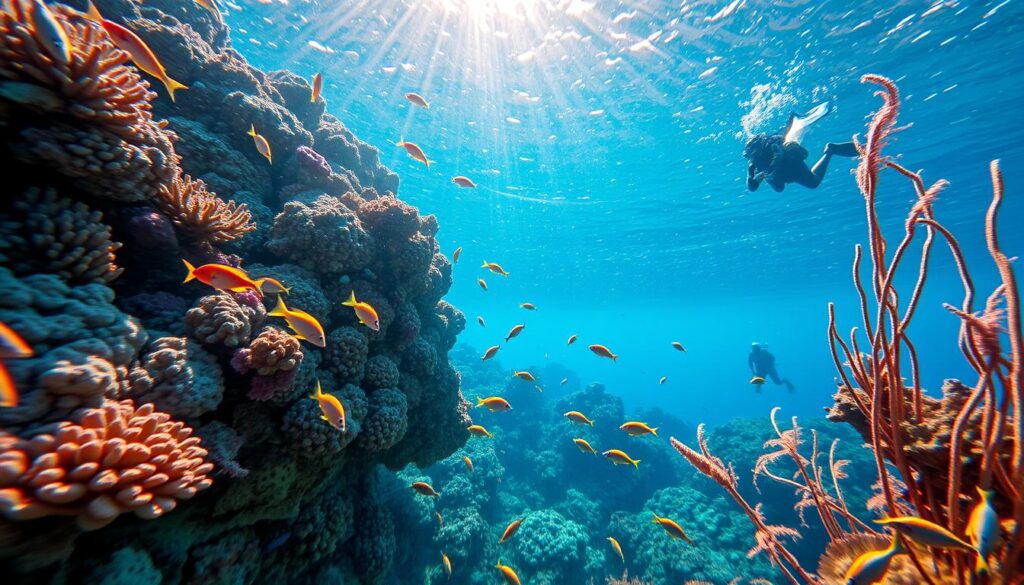
Divers are key in saving marine life and coral reefs. Now, over 80% of divers choose sustainable operators. These operators focus on saving the sea.
Protecting Coral Reefs
Caribbean coral reefs are very fragile. They make up about 10% of the world’s underwater life. Saving them is a must. Here are some ways to help:
- Maintain proper buoyancy control
- Use reef-safe sunscreen
- Avoid touching coral structures
- Support marine conservation programs
Responsible Wildlife Interaction
Watching marine life needs care. Divers should:
- Keep a respectful distance from marine creatures
- Never touch or feed underwater wildlife
- Use underwater cameras without disturbing habitats
Beach Clean-Up Initiatives
Many Caribbean resorts are working hard to save the sea. For example, Sandals and Beaches Resorts are:
| Conservation Achievement | Details |
|---|---|
| Green Fins Membership | 100% portfolio coverage across 8 Caribbean islands |
| PADI Certifications | Over 140,000 divers certified |
| Ocean Conservation | $50 donation per booking during “Gift of Blue” sale |
“Every dive is an opportunity to protect and respect our marine environments.” – Ocean Conservation Expert
By following these eco-friendly tips, divers can help keep the Caribbean’s coral reefs and marine life safe. This way, future generations can enjoy them too.
Scuba Diving Courses Offered in the Caribbean
The Caribbean is a unique place for learning scuba diving. It has warm waters, clear views, and many sea creatures. It’s perfect for those wanting to learn scuba diving.
There are many courses for all levels. You can find training centers all over the Caribbean. They offer great diving education.
PADI Certification Options
The Professional Association of Diving Instructors (PADI) has many certifications:
- Open Water Diver course for beginners
- Advanced Open Water Diver for skill enhancement
- Specialty certifications targeting specific diving interests
Advanced Training Opportunities
Sail Caribbean Divers offers deep training. They are known for:
- PADI Five-Star Instructor Development Dive Center
- Multiple land-based locations in the British Virgin Islands
- Professional staff maintaining top-rated scuba equipment
Unique Learning Environments
“The Caribbean offers more than just certification – it provides transformative underwater experiences.”
Students can see many sea places. From Bonaire’s coral gardens to Grenada’s sculpture park. Some courses even give college credit.
| Certification Level | Key Features |
|---|---|
| Open Water Diver | Entry-level course for beginners |
| Advanced Open Water | Enhanced skills in deep and navigation diving |
| Specialty Courses | Focus on specific diving techniques |
The Caribbean is great for diving all year. It has top instructors. It’s a favorite place for diving lovers.
Exploring Dive Resorts in the Caribbean
The Caribbean Islands have many dive resorts for all kinds of underwater fans. You can find places that are easy on the wallet or super fancy. Each spot offers a special way to enjoy tropical adventures.
Choosing the right dive resort can make your Caribbean diving trip amazing. The area has lots of places made just for scuba lovers. Each place has its own special charm.
All-Inclusive Diving Packages
Many Caribbean dive resorts offer all-inclusive deals that make planning easy. These deals usually include:
- Accommodation
- Unlimited shore and boat dives
- Equipment rental
- Meals and refreshments
- Airport transfers
Budget-Friendly Diving Stays
If you’re watching your budget, there are great dive resorts for you. For example, Sand Dollar Condominiums in Bonaire has 24-hour dive centre access. It’s a smart choice for budget-conscious divers.
Luxury Dive Resorts
For top-notch experiences, the Caribbean has luxury dive resorts. Anse Chastanet Resort in St. Lucia is a 600-acre estate. It’s the ultimate in diving luxury.
“The Caribbean offers dive resorts that transform underwater exploration into unforgettable experiences.”
When picking a dive resort in the Caribbean, think about a few things. Look at how close it is to dive spots, what facilities it has, and what else you can do there. Some places, like Anthony’s Key Resort, offer up to four dives a day. They’re perfect for those who love exploring the sea.
Understanding Dive Insurance
Scuba diving in the Caribbean is an amazing adventure. But, it’s important to have the right insurance. Medical emergencies can be costly, and even more so in remote areas.
Dive insurance is key for those exploring the Caribbean’s underwater world. It offers financial protection against risks that regular travel insurance might not cover.
Why Dive Insurance Matters
Diving has its own set of risks that need special insurance. The costs can add up quickly:
- Emergency medical treatments
- Hyperbaric chamber sessions
- Medical evacuations
- Equipment replacement
Types of Dive Insurance
There are different insurance plans for divers in the Caribbean:
| Insurance Plan | Coverage Limit | Annual Cost |
|---|---|---|
| Domestic Package | Up to $50,000 | $65 |
| Worldwide Master | Up to $125,000 | $100 |
| Worldwide Preferred | Up to $250,000 | $125 |
Choosing the Right Policy
When picking dive insurance for Caribbean trips, think about these things:
- Coverage limits for medical costs
- Emergency evacuation options
- Options for replacing equipment
- Depth and certification needs
“Dive insurance isn’t an expense – it’s an investment in your safety and peace of mind.” – Professional Diving Association
Pro tip: Make sure your policy covers diving in the Caribbean and fits your certification level.
Cultural Experiences Beyond Diving
The Caribbean Islands have more to offer than just underwater adventures. Snorkeling lets you explore the marine world, but there’s also a rich cultural scene to discover. It invites you to explore local experiences that go beyond the ocean.
Local Cuisine and Dining
Caribbean food is a mix of flavors from different cultures. Each island has its own special dishes that excite your taste buds:
- Fresh seafood caught daily
- Tropical fruits bursting with flavor
- Spices that tell stories of cultural migrations
Try dishes like Dominica’s mountain chicken and Montserrat’s goat water stew. They show the variety of food in the Caribbean.
Historical Sites and Museums
The Caribbean Islands have a rich history. You can see volcanic landscapes and colonial buildings. These places give deep insights into their past.
| Island | Unique Historical Feature |
|---|---|
| Montserrat | Soufrière Hills volcano site |
| Dominica | 365 rivers representing cultural resilience |
| Saba | Mount Scenery trail with panoramic views |
Engaging with Local Communities
Travelers can dive into Caribbean culture by:
- Participating in local festivals
- Visiting traditional markets
- Exploring community-based tourism initiatives
“The true essence of the Caribbean lies not just in its waters, but in the warmth of its people.”
These cultural experiences turn a simple trip into a journey of discovery in the Caribbean Islands.
Scuba Diving Travel Resources
Planning your underwater adventure in the Caribbean needs careful planning and trusted resources. Dive guides give key info on places like Cozumel, Bonaire, and Grand Cayman. They share details on marine life, dive spots, and local services to make your trip better.
Online platforms and travel sites have changed how we book dive resorts and packages. Sites like TripAdvisor and Dressel Divers offer discounts and packages for 6 to 18 dives. This makes it easy to compare prices, read reviews, and choose the best Caribbean diving spots.
Recommended Dive Guides
PADI’s travel resources and professional guides offer deep insights into Caribbean spots. They cover marine life, weather, and top dive sites. You can learn about places like Bonaire’s 100 shore diving spots or St. Lucia’s volcanic Pitons.
Online Reservations
Today, you can book diving packages online. Sites like Dressel Divers have options like SHRIMP, DOLPHIN, WHALE, and FAMILY packages. With costs from $1,000 to $1,500 a day, online booking helps plan and budget your dive trip.
Travel Insurance for Divers
Travel insurance is key for scuba diving trips. Good policies cover medical issues, lost gear, and trip cancellations for diving. Look for insurance that gets the risks of diving to offer peace of mind on your Caribbean dive.
Caribbean Recommended Scuba Diving Itinerary
Planning a scuba diving itinerary in the Caribbean can be an exciting endeavor, given the region’s abundance of incredible dive sites and diverse underwater landscapes. To help you make the most of your diving adventure, we’ve crafted a recommended scuba diving itinerary that showcases some of the best destinations and experiences the Caribbean has to offer. Get ready to embark on a thrilling journey beneath the turquoise waters of the Caribbean Sea.
Day 1-3: Bonaire – Dive into Paradise
Start your Caribbean diving itinerary in Bonaire, known as a diver’s paradise. Spend your first few days exploring the pristine reefs and vibrant marine life of this Dutch Caribbean island. Enjoy shore diving at Bonaire National Marine Park, with its easy access to over 80 dive sites. Don’t miss the opportunity to dive the famous Salt Pier and explore the stunning coral formations and abundant fish species.
Day 4-6: Cayman Islands – Walls and Wrecks
From Bonaire, head to the Cayman Islands, renowned for its breathtaking wall dives and captivating shipwrecks. Begin your Cayman diving experience in Grand Cayman, diving the famous sites along the dramatic drop-offs of Bloody Bay Wall and exploring the fascinating underwater world of the Kittiwake wreck. Then, venture to Cayman Brac or Little Cayman for more exhilarating wall dives and the chance to encounter majestic marine species.
Day 7-9: Roatán, Honduras – Coral Gardens and Marine Life
Continue your Caribbean diving journey in Roatán, a vibrant island off the coast of Honduras. Dive along the stunning coral reefs of the Roatán Marine Park, known for its colorful coral gardens and abundant marine life. Explore sites like Mary’s Place, where narrow canyons and swim-throughs create an enchanting underwater maze. Keep an eye out for encounters with turtles, eagle rays, and even whale sharks during certain seasons.
Day 10-12: St. Lucia – Volcanic Wonders and Marine Sanctuaries
Next, head to St. Lucia, where you’ll discover a unique blend of volcanic formations and marine sanctuaries. Dive the Anse Chastanet Marine Reserve, famous for its striking coral reefs, vibrant fish populations, and the annual coral spawning event. Explore the impressive walls and pinnacles of the Soufrière Marine Management Area, and don’t miss the opportunity to experience a mesmerizing night dive to witness the nocturnal marine life.
Day 13-15: Turks and Caicos Islands – Pristine Reefs and Marine Giants
Conclude your scuba diving itinerary in the Turks and Caicos Islands, a true gem of the Caribbean. Dive the exquisite coral reefs surrounding Providenciales, encountering an array of marine species, including graceful turtles, majestic humpback whales (during their migration season), and large schools of fish. Explore the famous dive sites of Northwest Point and Grace Bay, known for their pristine conditions and breathtaking underwater landscapes.
Throughout your scuba diving journey, take advantage of the services provided by professional diving centers and liveaboards in each destination. Seek guidance from experienced dive professionals, and consider participating in specialty dives such as night dives, drift dives, and wreck dives to add extra excitement and variety to your underwater exploration.
Remember to adhere to responsible diving practices, respect marine life and their habitats, and follow any local regulations and conservation initiatives. By being a mindful and conscientious diver, you can contribute to the preservation of the Caribbean’s remarkable underwater ecosystems for generations to come.
As your scuba diving adventure in the Caribbean comes to an end, you’ll carry memories of the diverse marine life, breathtaking landscapes, and unforgettable encounters with underwater wonders. The Caribbean’s allure as a scuba diving destination will continue to beckon, inviting you to return and discover even more of its captivating dive sites and experiences.
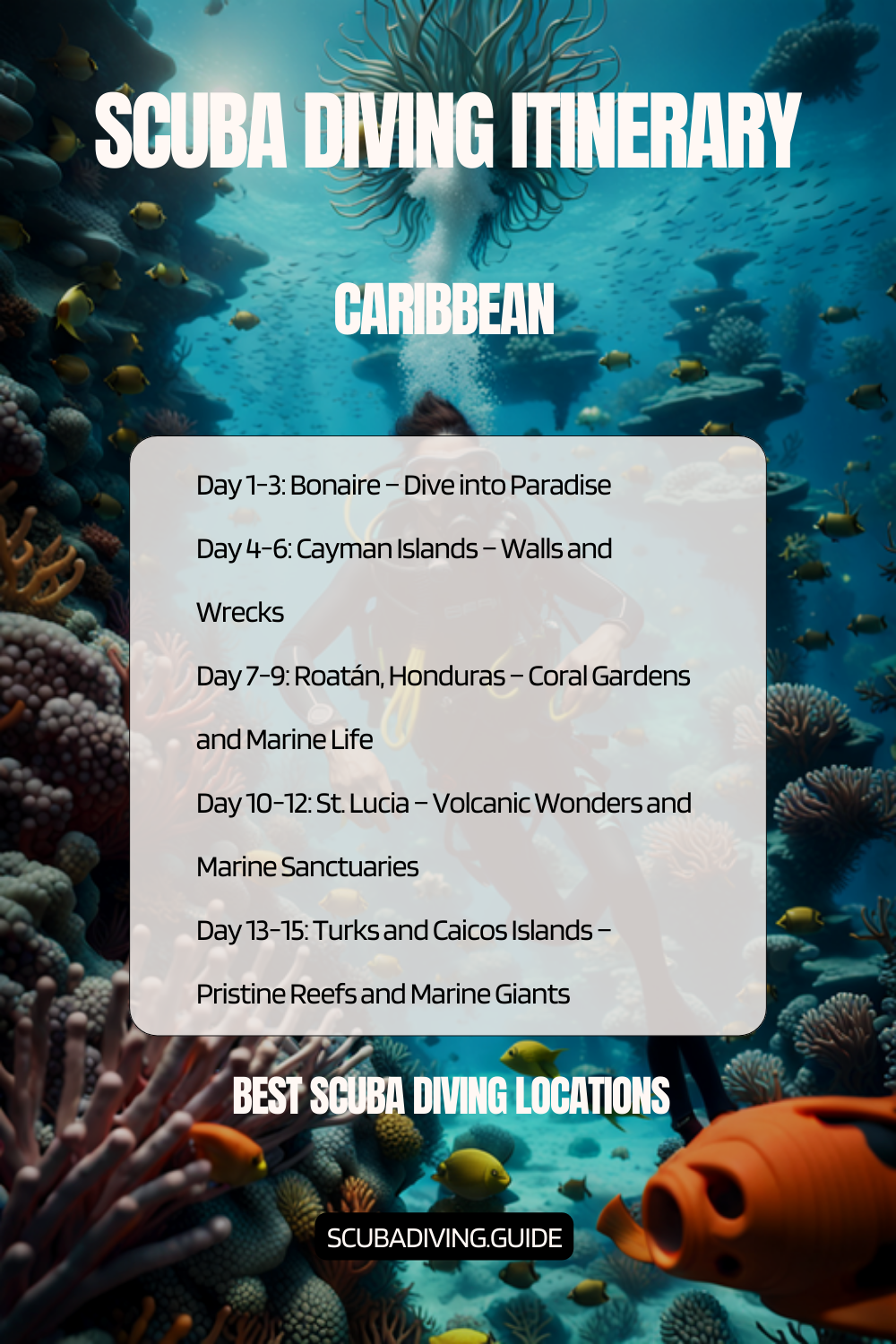
Countries to Consider
- Anguilla
- Antigua and Barbuda
- Aruba
- Bahamas
- Barbados
- Bonaire
- British Virgin Islands
- Cayman Islands
- Cuba
- Curaçao
- Dominica
- Dominican Republic
- Grenada
- Guadeloupe Islands
- Haiti
- Jamaica
- Martinique
- Montserrat
- Puerto Rico
- Saba
- Saint Barthélemy
- Saint Kitts & Nevis
- Saint Lucia
- Saint Vincent and the Grenadines
- Sint Eustatius
- Sint Maarten
- The Turks And Caicos Islands
- Trinidad and Tobago
- United States Virgin Islands
FAQ – Scuba Diving in Caribbean
Do I need prior diving experience to dive in the Caribbean?
No, the Caribbean welcomes divers of all levels. Many resorts offer courses for beginners. This way, you can learn and dive at the same time.
From basic lessons to advanced training, there’s something for everyone. You can find programs that match your skill level.
What is the best time of year to go scuba diving in the Caribbean?
The dry season, from December to April, is the best time to dive. You’ll enjoy clear waters and calm seas. But, the Caribbean is great for diving all year.
The wet season might be cheaper and less crowded. Just watch out for hurricanes.
What marine life can I expect to see while diving?
The Caribbean is home to amazing marine life. You’ll see colorful fish, sea turtles, sharks, octopuses, and seahorses. There are over 12,000 marine species to discover.
Explore vibrant coral reefs and dive into a world of beauty.
How much does scuba diving in the Caribbean typically cost?
Prices vary based on where you dive and the experience. Basic dives start at $50-$100. Dive packages at resorts cost $300-$1000 per person.
Certification courses are around $350-$500.
What safety precautions should I take while diving?
Always dive with a buddy and stick to your limits. Use the right equipment and listen to instructors. Know emergency procedures and stay fit.
Make sure you have dive insurance and follow local conditions.
Do I need to bring my own diving equipment?
Most places provide the basics like tanks and regulators. But, experienced divers might bring their own gear for comfort. A thin wetsuit or rash guard is enough for the Caribbean.
Which Caribbean destinations are best for diving?
Cozumel, Mexico, is great for drift diving. Bonaire is the shore diving capital. Grand Cayman is famous for wall dives and Stingray City.
Each place offers unique underwater adventures.
Is dive insurance necessary?
Yes, it’s highly recommended. Dive insurance covers medical emergencies and evacuations. It’s a safety net for unexpected incidents. Look for policies that fit your diving needs.
Can non-divers enjoy Caribbean underwater experiences?
Yes! Snorkeling is a great way for non-divers to explore the sea. Many resorts offer snorkeling tours. The Caribbean’s clear waters make it perfect for all skill levels.
How can I practice eco-friendly diving?
To protect the sea, dive carefully and avoid touching coral or marine life. Use reef-safe sunscreen and follow local guidelines. Many resorts focus on conservation and offer eco-friendly diving experiences.
